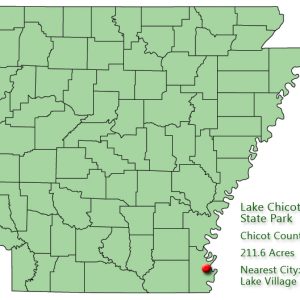calsfoundation@cals.org
Lake Chicot State Park
| Location: | Chicot County |
| Size: | 211.6 acres |
Lake Chicot State Park, located near Arkansas’s southeastern corner, provides recreational access to Arkansas’s largest natural lake, Lake Chicot, a twenty-mile-long oxbow created by the Mississippi River hundreds of years ago. Activities at the lake and its environs include fishing and bird watching.
Early in the twentieth century, the pure waters of the lake were used untreated by the city of Lake Village (Chicot County). The area became popular for its fishing, boating, and other recreational activities. The forests surrounding the lake served as a rich habitat for wildlife. The lake was polluted by a flood in 1916 and, beginning in 1920, work on the Mississippi River levee polluted it even more. Dredging, increased cultivation around the lake, and the resulting deposition of silt and pesticides throughout the 1930s, 1940s, and 1950s caused the water quality to deteriorate.
The Arkansas Game and Fish Commission (AGFC) realized the damage being done to the lake and attempted to preserve it. Arkansas’s first-ever study of its recreational needs—which was conducted by the State Parks Commission, the State Planning Board, and the National Park Service and published in 1940—recommended that Lake Chicot, uniquely valuable as the state’s largest natural lake and the nation’s largest natural oxbow, “be given prime consideration for an addition to the State park system.” In 1948, the AGFC constructed an earthen dam to separate the upper fourth of Lake Chicot from the runoff entering the lower portion of the lake via Connerly Bayou. The resulting improvement in water quality revitalized the beauty of the upper lake and inspired the creation of Lake Chicot State Park, an act made possible by a donation of land by Chicot County residents on the lake’s northwest shore in 1957. Hundreds of thousands of visitors per year returned to the upper lake. However, the recreational qualities of the polluted lower lake became nonexistent.
In 1985, a new pumping plant was installed to divert silt from the lake to the Mississippi River. Sport fish populations were restocked. Due to the area’s favorable climate and ecology, fishing conditions are once again excellent. Bass, catfish, crappie, bream, and a variety of other fishes are prolific.
Renovation of the park’s visitors’ center and other improvements were made following 1996 voter approval of a statewide one-eighth-percent sales tax, with proceeds earmarked for conservation and parks programs. Additional funding for improvements came from the Arkansas Natural and Cultural Resources Council. Park facilities include cabins, campsites, a store and marina, fishing piers, a swimming pool, pavilions, picnic areas, and hiking trails. Interpretive programs highlight area wildlife and Civil War history. The park celebrates the area’s blues and gospel music heritage with its annual Jammin’ in the Delta Blues Festival each June and Gospelfest each September.
For additional information:
Allen, Robert T. “Lake Chicot State Park.” Arkansas Naturalist 3 (January 1985): 8–11.
Arkansas State Parks–Lake Chicot. http://www.arkansasstateparks.com/lakechicot/default.aspx (accessed September 28, 2022).
Sutton, Keith. “The Death and Rebirth of Lake Chicot.” Arkansas Game and Fish, September/October 1985, pp. 5–9.
———. “Lake Chicot: A Natural State Natural.” Arkansas Game and Fish, March/April 1989, pp. 22–23.
Staff of the Arkansas Department of Parks and Tourism
Staff of the CALS Encyclopedia of Arkansas
 State Parks Division
State Parks Division Lake Chicot State Park
Lake Chicot State Park  Lake Chicot State Park: Park Location
Lake Chicot State Park: Park Location  Lake Chicot
Lake Chicot 




Comments
No comments on this entry yet.